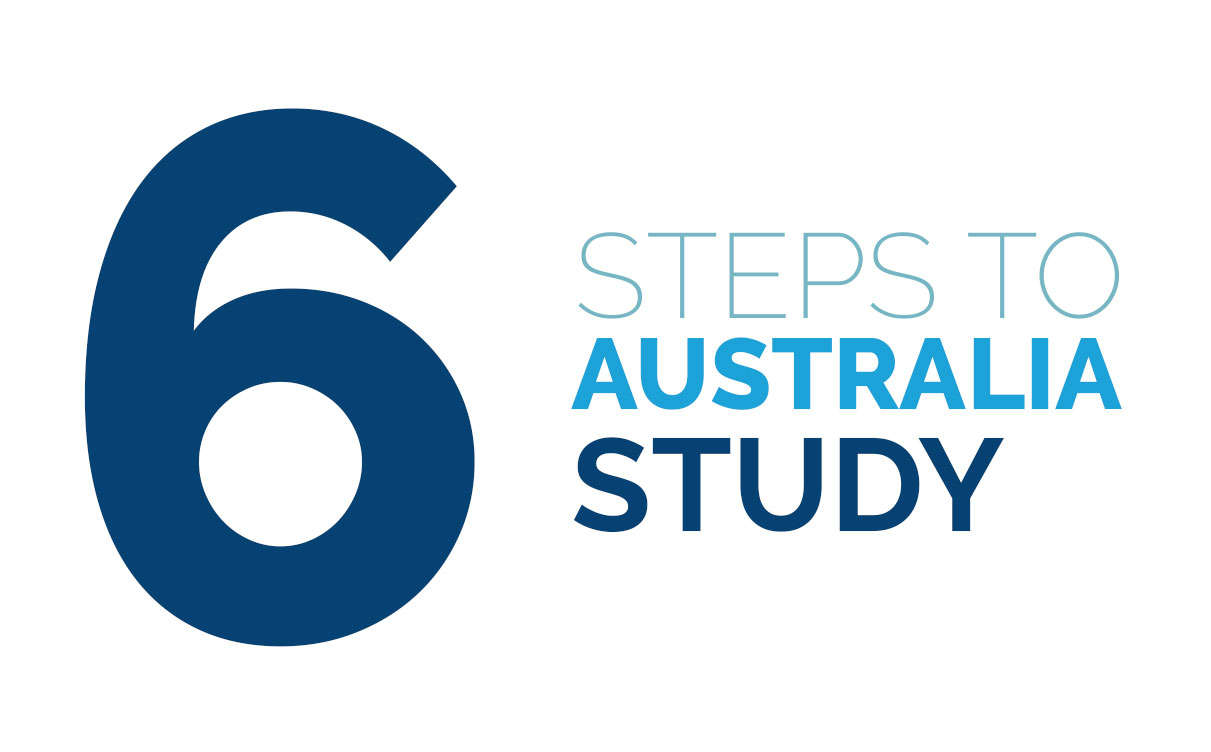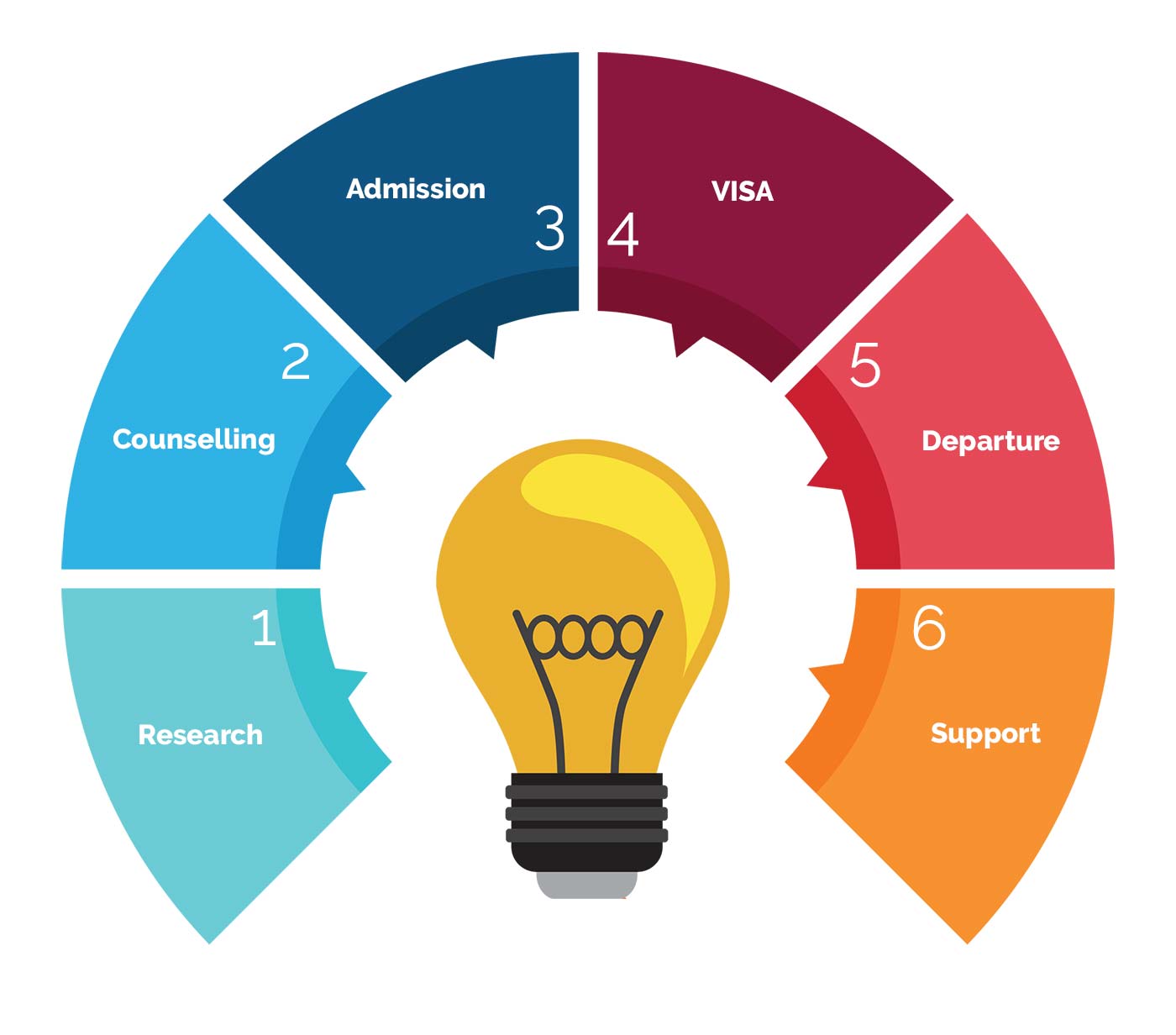

Step 1
Research all your options
Compare career opportunities derived from specific coursesLearn about a variety of universities and colleges to suit your background & finance
Step 2
Meet the GEC counselor
Our education counselors will study and evaluate all the possible study options for you based on your academic background, aspiration, budget, eligibility, work experience, etc.Step 3
Complete your application
Your GEC counselor will help you fill in the required forms; critique the statement of purpose and recommendation letters. Additionally, you will always be briefed with the latest news and information about visa requirements from the official sourcesStep 4
Application for visa
Your GEC counselor will guide you through the required documents for visa and lodge your application with the immigration departmentStep 5
Get ready for your departure
Our pre-departure session includes vital information from immigration compliance to what all you need to study and live in AustraliaStep 6
Ongoing support
You can always get in touch for any sort of guidance after reaching. If you would like to change your course, we are only one call awayAustralia is the sixth-biggest country in land area and the biggest island in the world. With the population of 23 million, it is one of the safest countries with no political unrest and strict gun laws which helps the country to retain lower crime rates. International students are warmly welcomed and it is common to see the professional and personal diversity in every walk of Australian culture. With more than 230 languages spoken, it is an embodiment of multiculturalism with magnanimous people.
Australia has seven of the top 100 universities in the world, with 22,000 courses across 1,100 institutions. More than 2.5 million international students have graduated from the Australian institutions to date and have gone on to make a difference after studying in Australia. This record itself speaks of volume, popularity and the established education pedigree. It has the third highest number of international students behind only the United States and the United Kingdom.
The Australian Government spends more than A$200 million in international scholarships each year. The objective of spending a great amount of money in scholarship is to invite the best brains of the world. Australia has five of the 30 best cities in the world for students based on safety, quality of life, commutation facilities, affordability and business activity. Australia has produced 15 Nobel prize laureates. Roughly over 1 billion people every day around the world rely on Australian innovations and discoveries – including IVF, ultrasound, penicillin, the Bionic ear, Wi-Fi, Black Box Flight Recorders and cervical cancer vaccines.
Universities
Tafes
Students Recruited

World-class education
Australia has earned the reputation of being excellent in offering both technical and vocational education to international students. Australian universities are widely recognized for their innovative and up-to-date course curriculum in any discipline.
Innovation
Australia is known for adopting the cutting-edge technologies at a faster pace compared with its peers. Adapting to new technologies and introducing them to various industries including the education sector helps build students for the future.
Quality Assurance
Australian government agency (TEQSA) monitors the quality of education. This department is committed to ensuring the best standards and practices in the education sector. Australia is the first country to enact the law namely ESOS Act to safeguard the interest of international students.
Welcoming community
International students are warmly welcomed and it is common to see the professional and personal diversity in every walk of Australian culture. With more than 230 languages spoken, it is an embodiment of multiculturalism with magnanimous people.
Scholarship
The Australian Government spends more than A$200 million in international scholarships each year. The objective of spending a great amount of money in scholarship is to invite the best brains of the world.
The Aussie edge
Australia has produced 15 Nobel prize laureates. Roughly over 1 billion people every day around the world rely on Australian innovations and discoveries – including IVF, ultrasound, penicillin, the Bionic ear, Wi-Fi, Black Box Flight Recorders and cervical cancer vaccines.

Australia offers various study options for students with 22,000 courses across 1,100 institutions to choose from.
Students have an option of studying at all levels from primary and senior secondary level schools, to vocational education and training (VET), from ELICOS (English language course) to higher and further education (including both universities and colleges). Depending upon the size of a university and teaching pattern, teaching generally takes place in large group lectures and small group tutorials.
Tertiary education
Tertiary education includes both higher education (including universities) and vocational education and training (VET).
Australian Qualification Framework
The Australian education system is distinguished from many other nations by the Australian Qualifications Framework (AQF). The AQF was established in 1995 and is a national policy that includes qualification from the tertiary education sector (higher education and vocational education and training) in addition to the school-leaving certificate; the Senior Secondary Certificate of Education.
Reference, and for more information visit: https://www.studyinaustralia.gov.au/english/australian-education/education-system
Work rights for international students
International students are authorized to work part-time up to 40 hours per fortnight while studying or full-time in the holidays, depending upon your visa conditions. They cannot work until they have commenced their course in Australia.

Universities
Fast facts about universities
- There are 43 universities (40 Australian universities, two international universities and one private specialty university)
- All universities are ranked among the world’s best by discipline
- Universities are state funded except the private and international ones
- ESOS Act safeguards the interest of international students
- Australian government agency (TEQSA) monitors the quality of education
- They offer courses right from certificate level to doctorate level
- They are research based – both applied and basic
- The academic course commences in February - March and ends in November
- Some have mid-year intakes (July) also
- 7 of the top 200 universities are based in Australia
List of Australian Universities state wise
Australian Capital Territory
- Australian National University
- University of Canberra
New South Wales
- Australian Catholic University
- Charles Sturt University
- Macquarie University
- Southern Cross University
- University of New England
- University of New South Wales
- University of Newcastle
- University of Sydney
- University of Technology, Sydney
- Western Sydney University
- University of Wollongong
Northern Territory
- Charles Darwin University
Queensland
- Bond University
- CQ University
- Federation University
- Griffith University
- James Cook University
- Queensland University of Technology
- University of Queensland
- University of Southern Queensland
- University of the Sunshine Coast
South Australian
- Carnegie Mellon University
- Flinders University
- Torrens University Australia
- University College London
- University of Adelaide
- University of South Australia
Tasmania
- University of Tasmania
Victoria
- Deakin University
- Federation University of Australia
- La Trobe University
- Monash University
- RMIT University
- Swinburne University of Technology
- University of Divinity
- University of Melbourne
- Victoria University
Western Australia
- Curtin University
- Edith Cowan University
- Murdoch University
- University of Notre Dame Australia
- University of Western Australia
Fast facts about Technical and Further Education (TAFEs)
- There are more than 50 TAFEs
- They are in partnership between governments and industry
- Small classroom size
- TAFEs are Covered under ESOS Act
- ASQA monitors the quality of education delivered
- Usually they have two to three intakes during the year
- Competitive tuition fees
- They offer certificate levels, diplomas, advanced diplomas and top-up degrees
List of TAFEs
Cost of studying

The cost of study varies considerably depending upon the university/college, city, study level and subject. Generally, courses in areas such as engineering, health science and medicine remain at the higher end of the scale.
Tuition Fees
According to Study in Australia, the official government website for international students, the annual tuition fees are as below:
- Bachelor’s degree: AU$15,000 to AU$33,000
- Master’s degree: AU$20,000 to AU$37,000
- Doctoral degree: AU$14,000 to AU$37,000
These figures indicate an average fee range at universities and do not include high-value courses such as medical degrees or veterinary, which could cost significantly more. For specific amount of tuition fees for your course, please visit the website of the relevant university and course. The offer letter of university/college/Tafe reads the exact amount of tuition fees.
Living costs
According to Department of Immigration and Border Protection (DIBP), the student must demonstrate the financial capacity to cover the 12-month living cost. The maintenance cost as per the government’s directives keeps changing with time and therefore, please keep visiting the website of government. As on 1 February 2018, in order to be eligible for an Australian student visa, you will need to show the below mentioned amount:
- Student or guardian: AU$20,290
- Partner or spouse: AU$7,100
- Child: AU$3,040
- School aged child: AU$8,000.
Travel costs
In addition to the living and studying costs, the student also needs to demonstrate the sufficient amount of funds that he can cover the trip to Australia for his education. Department of Immigration and Border Protection (DIBP) puts a specific figure for travel cost which is AU$2,000 for each applicant included in the visa application.

International students must buy overseas health coverage (OSHC) to cover all types of medical conditions and exigencies. Generally, universities or colleges have alliances with the medical insurance companies and they arrange the OSHC on your behalf.
The purchase of OSHC does not fall in line with the requirement of the 12-month option. You will need to purchase your insurance policy for the full length of course. For example, if your prospective course is of two years of length, you will need to demonstrate funds for the first twelve months, but you will need to buy OSHC for the two-year length.
Visa Requirements
Your GEC counselor will explain you about visa requirements for your Australia application.
In order to succeed in your student visa application, you must demonstrate your genuine intent to study, have enough financial support to pay your tuition fees, maintenance expenses and air tariff.
Your visa application will be lodged electronically.
You will need the following documents to lodge your student visa application:
- Visa application form (your counselor will help you complete the form)
- Visa application fees
- Offer letter
- Electronic confirmation of enrolment (ECOE) issued by your school
- Valid passport
- 4 photos (size 35mm*45mm, preferably in the white background and matte finish)
- Medical confirmation receipt
- Statement of purpose
- Academic credentials
- Proof of funds (your counselor will detail you fully)
- IELTS/PTE/TOEFL mark card
- Job credentials if applicable
- Any document/evidence applicable to your background (your counselor will guide)
Once your application is lodged, the system will automatically generate transaction reference number (TRN) on your application. You will receive the decision on your application electronically. Australia issues a label-free visa.
For more information about Australian student visa. Click here

It is not a new revelation that the US is one of the most expensive countries for an education destination, but do not let that pull you off. Because, there are ways to secure funding in various forms of scholarships, assistantships and grants. The only important factor to access to such funding, you need to be organized and on the lookout for various schemes offered by the government and university/college.
When evaluating your options of studying, it is common to distinguish between the ‘sticker price’ (the published rates) and the amount actually you pay once all the financial aids and sources of funding are taken into consideration.
For example, the top-notched universities with the highest sticker prices offer the most generous funding opportunities. At Caltech, almost 98% of graduate students and 99% of doctoral candidate receive full financial support, while 60% of undergraduate students receive the financial aid. Similarly at MIT, which is one of the highest ranked in the US and the world, more than 90% of undergraduate receive financial aid. Similar figures are seen by the leading US universities, with forms of support including grants, scholarships, assistantships and work-study schemes.
Here is the section of US scholarship awards for international students:
Government-funded US scholarships for international students
- Fulbright Foreign Student Program
- Hubert Humphrey Fellowship Program
Non-governmental US scholarship awards for international students:
- Abbey Road Summer Scholarships
- Civil Society Leadership Awards
- The Next Gen Scholarship Fund
- Tortuga Backpacks Study Abroad Scholarship
- Asian Women in Business Scholarship Fund
- Chicago Booth School of Business
- Cornell University Tata Scholarship
- Fulbright-Nehru Research Fellowships
- S.N. Bose Scholars Student Exchange Program for Indian Students
- Stanford Reliance Dhirubhai Fellowships for Indian Students
- Inlaks Shivdasani Foundation Scholarships
For Asian students:
- East-West Center Scholarships and Fellowships
- Japan-United States Friendship Commission
- Wesleyan Freeman Asian Scholarship Program
For female students:
- AAUW International Fellowships
- MIT-Zaragoza Women in Logistics and SCM scholarship
- Bat and Ball Game Women’s Sports Scholarship
For graduate students:
- Rotary Peace Fellowships
For students from developing countries:
- Aga Khan Foundation International Scholarship Program
- MasterCard Foundation Scholarships
University-specific US scholarship awards for international students:
- American University Emerging Global Leader Scholarship
- Brandeis University Wien International Scholarship Program
- Clark University Global Scholars Program
- Emory University Needs-Based Scholarship Program
- Harvard University Scholarships
- Illinois State University International Awards
- Iowa State University International Merit Scholarships
- Michigan State University International Scholarships
- New York University Wagner International Scholarships
- University of Arkansas International Scholarships
- University of Iowa Scholarships for International First Year Students
- University of Minnesota International Excellence Scholarships
- University of Oregon International Scholarships
- University of Wisconsin Superior Non-resident Tuition Waiver Program
Employment

Country overview
The main industries in Australia are tourism, financial and insurance services, mining, healthcare and social assistance, professional, scientific and technical services, manufacturing, construction, agriculture and food processing with the GDP of US$ 1.390 trillion in 2017. The economy works on free market principles and is open for foreign direct investment.
By numbers
GDP contributors as on 2017
|
AUD (billions)
|
% of total |
Services |
1,015.1 |
61.1 |
Mining |
114.9 |
6.9 |
Construction |
134.2 |
8.1 |
Manufacturing |
99.4 |
6.0 |
Agriculture |
36.7 |
2.2 |
Others |
Figures not available |
15.7 |
Source: Australian Industry Report 2016, Office of Chief Economist, Australian Government, Department of Industry, Innovation and Science
As per Australian Bureau of Statistics January 2018, the unemployment rate in Australia stands at 5.5%. Furthermore, the labor market portal shows the maximum jobs are available in the states of New South Wales, Victoria, Queensland and Western Australia.
Earn while you study
International students (subclass 500) are authorized to work part-time up to 40 hours per fortnight while studying or full-time in the holidays, depending upon their visa conditions. They cannot work until they have commenced their course in Australia. There are a wide range of industries for part-time employment opportunities for international students. Oftentimes, students are seen working for the following industries while they study:
- Retail: supermarkets, clothing stores, convenience stores and gas stations
- Tourism: motels and hotels and tour operators
- Agriculture: fruit- or vegetable-picking and packaging, farming
- Hospitality: restaurants, cafes, barista and bars
- Sales and marketing: telecommunication, electronic gadgets, etc.
- Tutoring
- Administration or clerical roles
Post-study work right
International students are eligible for the post-study work stream which falls under the Temporary Graduate (subclass 485) visa. To qualify for this post-study work rights, they must be bona fide students with completion of their degrees – diploma, bachelors, masters or PhD. This work permit allows you to gain practical experience in your relevant field following your studies. Please visit the official website of the government of Australia to learn more about your work rights: http://www.homeaffairs.gov.au/trav/stud
Source
https://www.studyinaustralia.gov.au/english/live-in-australia/working














